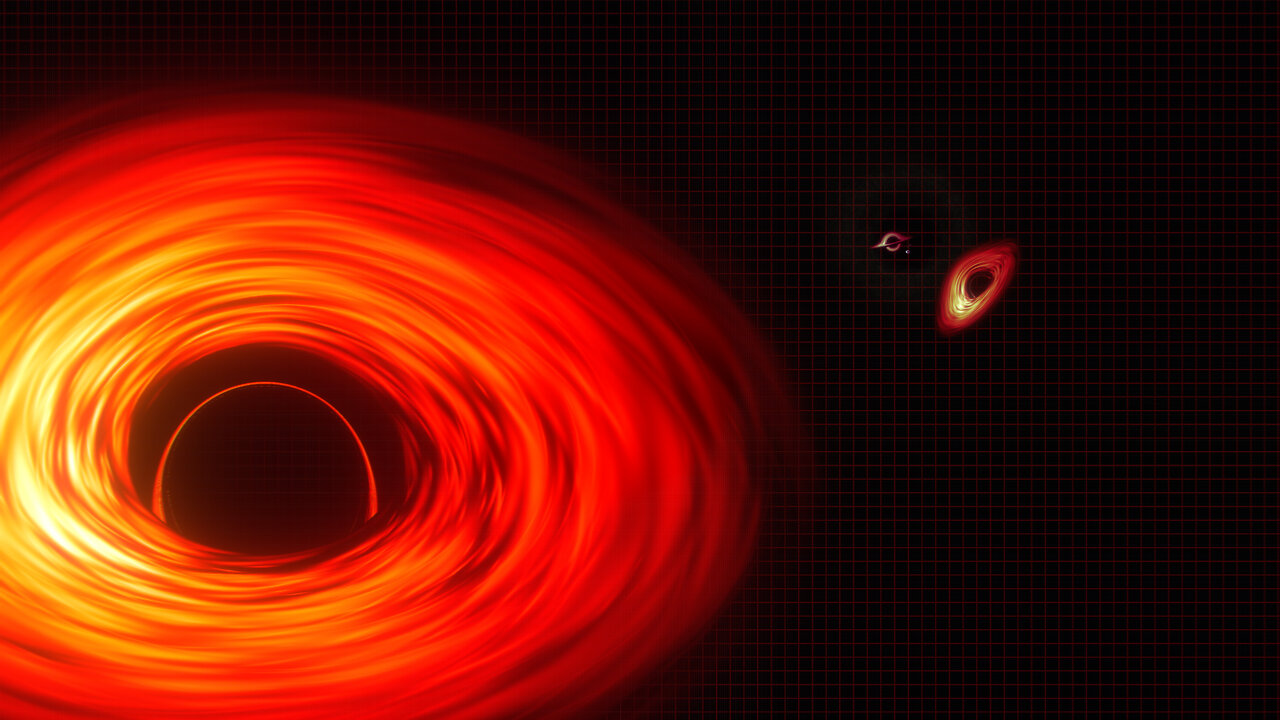Premium Only Content

AI Finds The Size Of Biggest Black Hole
Editor's Note: A previous version of this video mislabeled
the orbit of Saturn as the orbit of Jupiter.
This new NASA animation highlights the "super" in
supermassive black holes. These monsters lurk in the
centers of most big galaxies, including our own Milky Way,
and contain between 100,000 and tens of billions of times
more mnass than our Sun.
Any light crossing the event horizon - the black hole's
point of no return - becomes trapped forever, and any
light passing close to it is redirected by the black hole's
intense gravity. Together, these effects produce a
"shadow" about twice the size of the black hole's actual
event horizon.
The animation shows 10 supersized black holes that
occupy center stage in their host galaxies, including the
Milky Way and M87, scaled by the sizes of their shadows.
Starting near the Sun, the camera steadily pulls back to
compare ever-larger black holes to different structures in
our solar system.
First up is 1601+3113, a dwarf galaxy hosting a black hole
packed with the mass of 100,000 Suns. The matter is so
compressed that even the black hole's shadow is smaller
than our Sun.
The black hole at the heart of our own galaxy, called
Sagittarius A* (pronounced ay-star), boasts the weight of
4.3 million Suns based on long-term tracking of stars in
orbit around it. It's shadow diameter spans about half that
of Mercury's orbit in our solar system.
The animation shows two monster black holes in the
galaxy known as NGC 7727. Located about 1,600
light-years apart, one weighs 6 million solar masses and
the other more than 150 million Suns. Astronomers saythe pair will merge within the next 250 million years.
At the animation's larger scale lies M87's black hole, now
with a updated mass of 5.4 billion Suns. Its shadow is so
big that even a beam of light - traveling at 670 million
mph (1 billion kph) - would take about two and a half days
to cross it.
The movie ends with TON 618, one of a handful of
extremely distant and massive black holes for which
astronomers have direct measurements. This behemoth
Contains more than 60 billion solar masses, and it boasts
a shadow so large that a beam of light would take weeks
to traverse it.
Music credit: "In the Stars" from Universal Production
Music
Credit: NASA's Goddard Space Flight Center Conceptual
Image Lab
Lead Producer: Scott Wiessinger (KBRwyle)
Lead Animator: Krystofer Kim (KBRwyle)
Lead Science writer: Francis Reddy (University of Maryland
College Park)
Visualizer: Jeremy Schnittman (NASA/GSFC)
Producer: Sophia Roberts (AIMM)
Scientist: Jeremy Schnittman (NASA/GSFC)
-
 UPCOMING
UPCOMING
Awaken With JP
1 hour agoObama Incrimination, Epstein Hoax, and Plenty of Nonsense - LIES Ep 101
-
 1:00:04
1:00:04
Russell Brand
2 hours agoDr. Oz and the War for Your Health - SF618
47.7K12 -
 LIVE
LIVE
Viss
2 hours ago🔴LIVE - Your Helping Hand to Winning In PUBG!
448 watching -
 DVR
DVR
Sean Unpaved
2 hours agoJerry's Soundbites, Bengals' Hopes, & Mike Brown's Bold Take
5.24K1 -
 LIVE
LIVE
LadyDesireeMusic
9 minutes agoLive Piano Renditions | Make Ladies Great Again | Live Piano Requests TONS to choose from
91 watching -
 1:04:17
1:04:17
Timcast
2 hours agoGOP SHUTS House Votes BLOCKING Massie/Khanna Epstein Files Release
106K102 -
 11:57
11:57
Michael Button
4 hours agoAre We Missing an Ancient Sea-Faring Culture?
1002 -
 1:43:50
1:43:50
The Confessionals
2 hours agoNavy Pilot’s Drug Bust Mission Turns UFO Chase Over Open Ocean (Then It Went Underwater)
123 -
 LIVE
LIVE
StoneMountain64
1 hour agoBattlefield 6 CONFIRMED + Delta Force Escaping PRISON with PROS
183 watching -
 LIVE
LIVE
ROSE UNPLUGGED
16 hours agoInside Trump’s Game-Changing Law
30 watching